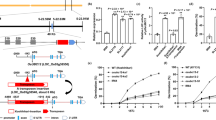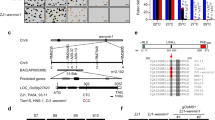Abstract
Global warming threatens many aspects of human life1,2, for example, by reducing crop yields3,4,5. Breeding heat-tolerant crops using genes conferring thermotolerance is a fundamental way to help deal with this challenge4,5,6,7,8,9. Here we identify a major quantitative trait locus (QTL) for thermotolerance in African rice (Oryza glaberrima), Thermo-tolerance 1 (TT1), which encodes an α2 subunit of the 26S proteasome involved in the degradation of ubiquitinated proteins. Ubiquitylome analysis indicated that OgTT1 protects cells from heat stress through more efficient elimination of cytotoxic denatured proteins and more effective maintenance of heat-response processes than achieved with OsTT1. Variation in TT1 has been selected for on the basis of climatic temperature and has had an important role in local adaptation during rice evolution. In addition, we found that overexpression of OgTT1 was associated with markedly enhanced thermotolerance in rice, Arabidopsis and Festuca elata. This discovery may lead to an increase in crop security in the face of the ongoing threat of global warming.
This is a preview of subscription content, access via your institution
Access options
Subscribe to this journal
Receive 12 print issues and online access
$209.00 per year
only $17.42 per issue
Buy this article
- Purchase on Springer Link
- Instant access to full article PDF
Prices may be subject to local taxes which are calculated during checkout




Similar content being viewed by others
Accession codes
References
IPCC. 2014: Summary for policymakers. In Climate Change 2014: Impacts, Adaptation, and Vulnerability. Part A: Global and Sectoral Aspects. Contribution of Working Group II to the Fifth Assessment Report of the Intergovernmental Panel on Climate Change (eds. Field, C.B. et al.). 1–32 (Cambridge University Press, 2014).
Bohra-Mishra, P., Oppenheimer, M. & Hsiang, S.M. Nonlinear permanent migration response to climatic variations but minimal response to disasters. Proc. Natl. Acad. Sci. USA 111, 9780–9785 (2014).
Peng, S. et al. Rice yields decline with higher night temperature from global warming. Proc. Natl. Acad. Sci. USA 101, 9971–9975 (2004).
Battisti, D.S. & Naylor, R.L. Historical warnings of future food insecurity with unprecedented seasonal heat. Science 323, 240–244 (2009).
Lobell, D.B., Schlenker, W. & Costa-Roberts, J. Climate trends and global crop production since 1980. Science 333, 616–620 (2011).
Mba, C., Guimaraes, E.P. & Ghosh, K. Re-orienting crop improvement for the changing climatic conditions of the 21st century. Agriculture & Food Security 1, 7 (2012).
Takeda, S. & Matsuoka, M. Genetic approaches to crop improvement: responding to environmental and population changes. Nat. Rev. Genet. 9, 444–457 (2008).
Zhu, C.L. et al. Mapping QTL for heat-tolerance at grain filling stage in rice. Rice Science 12, 33–38 (2005).
Wei, H. et al. A dominant major locus in chromosome 9 of rice (Oryza sativa L.) confers tolerance to 48 °C high temperature at seedling stage. J. Hered. 104, 287–294 (2013).
Lyman, N.B., Jagadish, K.S.V., Nalley, L.L., Dixon, B.L. & Siebenmorgen, T. Neglecting rice milling yield and quality underestimates economic losses from high-temperature stress. PLoS One 8, e72157 (2013).
Trnka, M. et al. Adverse weather conditions for European wheat production will become more frequent with climate change. Nat. Clim. Chang. 4, 637–643 (2014).
Semenov, M.A. & Shewry, P.R. Modelling predicts that heat stress, not drought, will increase vulnerability of wheat in Europe. Sci. Rep. 1, 66 (2011).
Sarla, N. & Swamy, B.P.M. Oryza glaberrima: a source for the improvement of Oryza sativa. Curr. Sci. 89, 955–963 (2005).
Sakai, H. et al. Distinct evolutionary patterns of Oryza glaberrima deciphered by genome sequencing and comparative analysis. Plant J. 66, 796–805 (2011).
Linares, O.F. African rice (Oryza glaberrima): history and future potential. Proc. Natl. Acad. Sci. USA 99, 16360–16365 (2002).
Luo, J.J., Hao, W., Jin, J., Gao, J.P. & Lin, H.X. Fine mapping of Spr3, a locus for spreading panicle from African cultivated rice (Oryza glaberrima Steud.). Mol. Plant 1, 830–838 (2008).
Wang, S., Kurepa, J. & Smalle, J.A. The Arabidopsis 26S proteasome subunit RPN1a is required for optimal plant growth and stress responses. Plant Cell Physiol. 50, 1721–1725 (2009).
Peng, Z. et al. The cellular level of PR500, a protein complex related to the 19S regulatory particle of the proteasome, is regulated in response to stresses in plants. Mol. Biol. Cell 12, 383–392 (2001).
Nishizawa-Yokoi, A. et al. The 26S proteasome function and Hsp90 activity involved in the regulation of HsfA2 expression in response to oxidative stress. Plant Cell Physiol. 51, 486–496 (2010).
Lee, K.H. et al. The RPT2 subunit of the 26S proteasome directs complex assembly, histone dynamics, and gametophyte and sporophyte development in Arabidopsis. Plant Cell 23, 4298–4317 (2011).
Book, A.J. et al. The RPN5 subunit of the 26S proteasome is essential for gametogenesis, sporophyte development, and complex assembly in Arabidopsis. Plant Cell 21, 460–478 (2009).
Ueda, M. et al. The HALTED ROOT gene encoding the 26S proteasome subunit RPT2a is essential for the maintenance of Arabidopsis meristems. Development 131, 2101–2111 (2004).
Huang, W. et al. The proteolytic function of the Arabidopsis 26S proteasome is required for specifying leaf adaxial identity. Plant Cell 18, 2479–2492 (2006).
Gallois, J.L. et al. The Arabidopsis proteasome RPT5 subunits are essential for gametophyte development and show accession-dependent redundancy. Plant Cell 21, 442–459 (2009).
Brukhin, V., Gheyselinck, J., Gagliardini, V., Genschik, P. & Grossniklaus, U. The RPN1 subunit of the 26S proteasome in Arabidopsis is essential for embryogenesis. Plant Cell 17, 2723–2737 (2005).
Kurepa, J. & Smalle, J.A. Structure, function and regulation of plant proteasomes. Biochimie 90, 324–335 (2008).
Vierstra, R.D. The ubiquitin-26S proteasome system at the nexus of plant biology. Nat. Rev. Mol. Cell Biol. 10, 385–397 (2009).
Huber, E.M. et al. Immuno- and constitutive proteasome crystal structures reveal differences in substrate and inhibitor specificity. Cell 148, 727–738 (2012).
Groll, M. et al. Structure of 20S proteasome from yeast at 2.4 Å resolution. Nature 386, 463–471 (1997).
Vierstra, R.D. The ubiquitin/26S proteasome pathway, the complex last chapter in the life of many plant proteins. Trends Plant Sci. 8, 135–142 (2003).
Bhattacharyya, S., Yu, H., Mim, C. & Matouschek, A. Regulated protein turnover: snapshots of the proteasome in action. Nat. Rev. Mol. Cell Biol. 15, 122–133 (2014).
Ruschak, A.M., Religa, T.L., Breuer, S., Witt, S. & Kay, L.E. The proteasome antechamber maintains substrates in an unfolded state. Nature 467, 868–871 (2010).
Groll, M. et al. A gated channel into the proteasome core particle. Nat. Struct. Biol. 7, 1062–1067 (2000).
Kim, W. et al. Systematic and quantitative assessment of the ubiquitin-modified proteome. Mol. Cell 44, 325–340 (2011).
Udeshi, N.D., Mertins, P., Svinkina, T. & Carr, S.A. Large-scale identification of ubiquitination sites by mass spectrometry. Nat. Protoc. 8, 1950–1960 (2013).
Wang, M. et al. The genome sequence of African rice (Oryza glaberrima) and evidence for independent domestication. Nat. Genet. 46, 982–988 (2014).
Hao, W., Jin, J., Sun, S.Y., Zhu, M.Z. & Lin, H.X. Construction of chromosome segment substitution lines carrying overlapping chromosome segments of the whole wild rice genome and identification of quantitative trait loci for rice quality. Zhi Wu Sheng Li Yu Fen Zi Sheng Wu Xue Xue Bao 32, 354–362 (2006).
Hao, W., Zhu, M.Z., Gao, J.P., Sun, S.Y. & Lin, H.X. Identification of quantitative trait loci for rice quality in a population of chromosome segment substitution lines. J. Integr. Plant Biol. 51, 500–512 (2009).
Huang, X. et al. A map of rice genome variation reveals the origin of cultivated rice. Nature 490, 497–501 (2012).
Baniwal, S.K. et al. Heat stress response in plants: a complex game with chaperones and more than twenty heat stress transcription factors. J. Biosci. 29, 471–487 (2004).
Hasanuzzaman, M., Nahar, K., Alam, M.M., Roychowdhury, R. & Fujita, M. Physiological, biochemical, and molecular mechanisms of heat stress tolerance in plants. Int. J. Mol. Sci. 14, 9643–9684 (2013).
Yanagawa, Y. et al. Purification and characterization of the 26S proteasome from cultured rice (Oryza sativa) cells. Plant Sci. 149, 33–41 (1999).
Shibahara, T., Kawasaki, H. & Hirano, H. Identification of the 19S regulatory particle subunits from the rice 26S proteasome. Eur. J. Biochem. 269, 1474–1483 (2002).
International Rice Genome Sequencing Project. The map-based sequence of the rice genome. Nature 436, 793–800 (2005).
Mao, J., Zhang, Y.C., Sang, Y., Li, Q.H. & Yang, H.Q. A role for Arabidopsis cryptochromes and COP1 in the regulation of stomatal opening. Proc. Natl. Acad. Sci. USA 102, 12270–12275 (2005).
Warthmann, N., Chen, H., Ossowski, S., Weigel, D. & Herve, P. Highly specific gene silencing by artificial miRNAs in rice. PLoS One 3, e1829 (2008).
Hiei, Y., Ohta, S., Komari, T. & Kumashiro, T. Efficient transformation of rice (Oryza sativa L.) mediated by Agrobacterium and sequence-analysis of the boundaries of the T-DNA. Plant J. 6, 271–282 (1994).
Gao, C., Liu, J.X. & Nielsen, K.K. Agrobacterium-mediated transformation of meadow fescue (Festuca pratensis Huds.). Plant Cell Rep. 28, 1431–1437 (2009).
Clough, S.J. & Bent, A.F. Floral dip: a simplified method for Agrobacterium-mediated transformation of Arabidopsis thaliana. Plant J. 16, 735–743 (1998).
Sun, S.Y. et al. OsHAL3 mediates a new pathway in the light-regulated growth of rice. Nat. Cell Biol. 11, 845–851 (2009).
Wiśniewski, J.R., Zougman, A., Nagaraj, N. & Mann, M. Universal sample preparation method for proteome analysis. Nat. Methods 6, 359–362 (2009).
Subramanian, A. et al. Gene set enrichment analysis: a knowledge-based approach for interpreting genome-wide expression profiles. Proc. Natl. Acad. Sci. USA 102, 15545–15550 (2005).
Mootha, V.K. et al. PGC-1α-responsive genes involved in oxidative phosphorylation are coordinately downregulated in human diabetes. Nat. Genet. 34, 267–273 (2003).
Huang, X. et al. Genome-wide association studies of 14 agronomic traits in rice landraces. Nat. Genet. 42, 961–967 (2010).
Acknowledgements
We thank G.Q. Zhang and the National Mid-term Genebank for Rice of China National Rice Research Institute for kindly providing O. glaberrima and O. sativa from Africa, respectively. We thank Y. Li for help with bioinformatics analysis. This work was supported by grants from the Ministry of Science and Technology of China (2012AA10A302, 2012CB944800), the National Natural Science Foundation of China (31421093, 31101128), the CAS-Croucher Funding Scheme for Joint Laboratories, the China Postdoctoral Science Foundation, and the Research Grants Council of Hong Kong (CUHK2/CRF/11G and AoE/M-05/12).
Author information
Authors and Affiliations
Contributions
H.-X.L. conceived and supervised the project. H.-X.L., J.-P.G., J.-X.S. and X.-M.L. designed the experiments. X.-M.L. carried out most of the experiments. D.-Y.C., Y.W., X.H., K.C., L.-G.C., L.S., W.-W.Y., H.C., H.-C.C., N.-Q.D., T.G., M.S., Q.F., P.Z., B.H., J.-X.S., J.-P.G. and H.-X.L. carried out some of the experiments. X.-M.L., D.-Y.C. and H.-X.L. analyzed data and wrote the manuscript.
Corresponding authors
Ethics declarations
Competing interests
The authors declare no competing financial interests.
Supplementary information
Supplementary Text and Figures
Supplementary Figures 1–16 and Supplementary Tables 2 and 3 (PDF 44712 kb)
Supplementary Table 1
Summary of differentially ubiquitinated sites and corresponding proteins identified and quantified (two-way ANOVA, P(interaction) < 0.05) (XLSX 125 kb)
Rights and permissions
About this article
Cite this article
Li, XM., Chao, DY., Wu, Y. et al. Natural alleles of a proteasome α2 subunit gene contribute to thermotolerance and adaptation of African rice. Nat Genet 47, 827–833 (2015). https://doi.org/10.1038/ng.3305
Received:
Accepted:
Published:
Issue Date:
DOI: https://doi.org/10.1038/ng.3305
This article is cited by
-
Natural variation of STKc_GSK3 kinase TaSG-D1 contributes to heat stress tolerance in Indian dwarf wheat
Nature Communications (2024)
-
Identification of hub genes that variate the qCSS12-mediated cold tolerance between indica and japonica rice using WGCNA
Plant Cell Reports (2024)
-
A DNA adenine demethylase impairs PRC2-mediated repression of genes marked by a specific chromatin signature
Genome Biology (2023)
-
Utilization of natural alleles for heat adaptability QTLs at the flowering stage in rice
BMC Plant Biology (2023)
-
RGA1 Negatively Regulates Thermo-tolerance by Affecting Carbohydrate Metabolism and the Energy Supply in Rice
Rice (2023)



